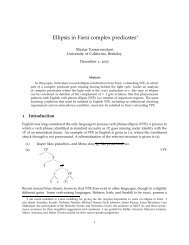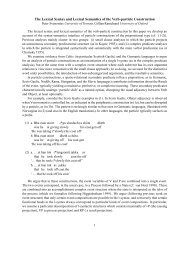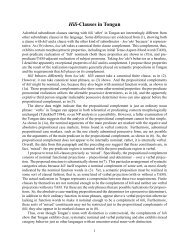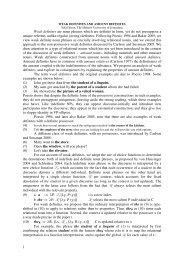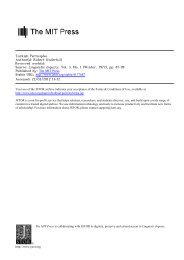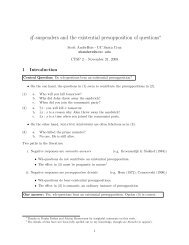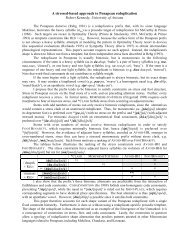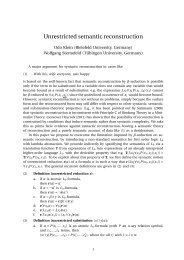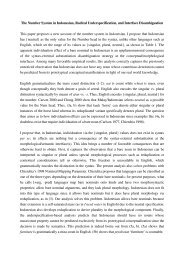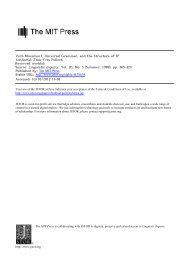LONG DISTANCE AGREEMENT IN HINDI-URDUw This paper ...
LONG DISTANCE AGREEMENT IN HINDI-URDUw This paper ...
LONG DISTANCE AGREEMENT IN HINDI-URDUw This paper ...
You also want an ePaper? Increase the reach of your titles
YUMPU automatically turns print PDFs into web optimized ePapers that Google loves.
774RAJESH BHATTIn Gujarati, ergative subjects do not agree, but overtly case-markedaccusative objects do (cf. Subbarao 2001).(27) (Gujarati, from Cardona (1965: 75))a. mEN tehmahri behEn-one bolawiI-Erg your sisters-Acc invited.F‘I invited your sisters.’b. pustek ‘book’ is NeutermEN a pustek-ne waNcyuNI-Erg this book-Acc read.N‘I read this book.’In both (27a,b), the verb does not agree with the Ergative subject. Itdoes, however, agree with the overtly case-marked accusative object.Because of the variation in the effect of overt case-marking onagreement, Subbarao (2001) notes, and I concur, that the effect ofovert case-marking on agreement should be treated as an instance ofparametric variation and not as a universal. The Nepali facts demonstratethat languages differ with respect to whether the presence ofovert case-marking blocks agreement. The Gujarati facts further revealthat even within a language, case-markers differ in whether theyblock agreement. Ergative case-marking in Gujarati blocks agreementbut not accusative case-marking. See Comrie (1984) and Deoand Sharma (2002) for a discussion of the variation manifested withinthe Modern Indo-Aryan languages with respect to the relationshipbetween overt case-marking on a DP and the visibility of that XP’sagreement features.3.3. DirectionalityWhen there is Long Distance Agreement, we find an embedded objectagreeing with the matrix T 0 . However, the reverse process, where theinfinitival verb agrees with the matrix subject, is not attested (cf. 28). 66 The directionality facts provide a clear argument against a naı¨ve restructuringanalysis of LDA. According to such an analysis, Long Distance Agreement wouldinvolve ‘clause union’ i.e. all the verbs would form a single unit which would togethercombine with the nominal arguments. But then given the agreement system of Hindi-Urdu, such an analysis would make the incorrect prediction that (28b) is grammatical.<strong>This</strong> argument does not carry over to more sophisticated analyses ofrestructuring such as Wurmbrand (2001) which do not handle restructuring phenomenain terms of ‘clause union’.



